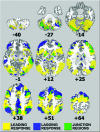The neural processes underlying self-agency
- PMID: 20378581
- PMCID: PMC3000563
- DOI: 10.1093/cercor/bhq059
The neural processes underlying self-agency
Abstract
Self-agency (SA) is the individual's perception that an action is the consequence of his/her own intention. The neural networks underlying SA are not well understood. We carried out a novel, ecologically valid, virtual-reality experiment using blood oxygen level-dependent functional magnetic resonance imaging (fMRI) where SA could be modulated in real-time while subjects performed voluntary finger movements. Behavioral testing was also performed to assess the explicit judgment of SA. Twenty healthy volunteers completed the experiment. Results of the behavioral testing demonstrated paradigm validity along with the identification of a bias that led subjects to over- or underestimate the amount of control they had. The fMRI experiment identified 2 discrete networks. These leading and lagging networks likely represent a spatial and temporal flow of information, with the leading network serving the role of mismatch detection and the lagging network receiving this information and mediating its elevation to conscious awareness, giving rise to SA.
Figures






References
-
- Blakemore SJ, Sirigu A. Action prediction in the cerebellum and in the parietal lobe. Exp Brain Res. 2003;53:239–245. - PubMed
-
- Cohen MS. Parametric analysis of fMRI data using linear systems methods. Neuroimage. 1997;6:93–103. - PubMed
-
- Costantini M, Haggard P. The rubber hand illusion: sensitivity and reference frame for body ownership. Conscious Cogn. 2007;16:229–240. - PubMed
-
- Cox RW. AFNI: Software for analysis and visualization of functional magnetic resonance neuroimages. Computers and Biomedical Research. 1996;29:162–173. - PubMed
Publication types
MeSH terms
Grants and funding
LinkOut - more resources
Full Text Sources
Other Literature Sources

